
The men's discus throw was one of four men's throwing events on the Athletics at the 1964 Summer Olympics program in Tokyo. It was held on 15 October 1964. 29 athletes from 21 nations entered, with 1 additional athlete not starting in the qualification round. The maximum number of athletes per nation had been set at 3 since the 1930 Olympic Congress. The event was won by Al Oerter of the United States, the nation's fourth consecutive and 11th overall victory in the men's discus throw. Oerter became the first man to win three medals in the event, all of them gold. He was only the second person to win three consecutive gold medals in any individual athletics event. It was the third of his four consecutive wins in the event. Ludvik Danek of Czechoslovakia took silver to break up the Americans' two-Games dominance of the discus podium; no non-American had won a medal since 1952. Dave Weill earned bronze to make this the fourth straight Games that the United States had won at least two medals in the event.

The men's discus throw was one of six throwing events on the Athletics at the 1908 Summer Olympics programme in London. The competition was held on 16 July 1908. 42 throwers from eleven nations competed. NOCs could enter up to 12 athletes. The event was won by Martin Sheridan of the United States, his second consecutive victory in the event. The Americans completed their first sweep in the discus throw, with Merritt Giffin taking silver and Bill Horr bronze.
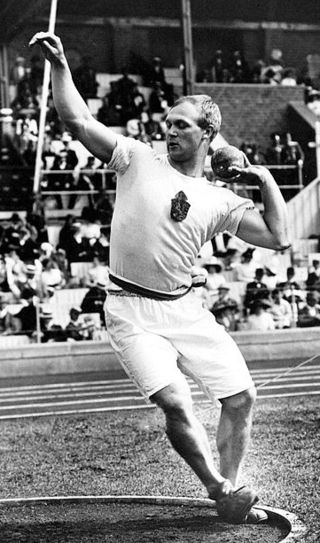
Elmer Konstantin Niklander was a Finnish athlete who competed in throwing events, winning the gold medal in the 1920 discus throw and three other Olympic medals and 44 Finnish championships.

Finland competed at the 1912 Summer Olympics in Stockholm, Sweden. The Grand Duchy of Finland was an autonomous part of the Russian Empire at the time, which allowed Finland to compete separately of Russia Russia at the 1908 Summer Olympics due to Finland's special status. During the opening ceremony, Finland's team paraded under the national insignia flag of a Swedish-speaking female gymnastics club in Helsinki. 164 competitors, 162 men and 2 women, took part in 49 events in 10 sports.

Finland competed at the 1920 Summer Olympics in Antwerp, Belgium for the first time as a fully independent state. It competed independently in 1908 and 1912 as the autonomous Grand Duchy of Finland within the Russian Empire. 63 competitors, 62 men and 1 woman, took part in 51 events in 9 sports.

Armas Rudolf Taipale was a Finnish athlete, who competed at three Olympic Games in 1912, 1920 and 1924 and won two gold medals and a silver medal.

The men's shot put was a track and field athletics event held as part of the athletics at the 1912 Summer Olympics programme. The competition was held on Wednesday, July 10, 1912. Twenty-two shot putters from 14 nations competed. NOCs could enter up to 12 athletes. The event was won by Pat McDonald of the United States, the nation's fifth consecutive victory in the men's shot put. The American team swept the top three places, the third time in five Games. Ralph Rose took silver, 9 centimetres shy of a third gold medal; he became the first man to win three medals of any color.

The men's discus throw was a track and field athletics event held as part of the athletics at the 1912 Summer Olympics programme. The competition was held on Friday, July 12, 1912. Forty-one discus throwers from 15 nation competed. NOCs could enter up to 12 athletes. The event was won by Armas Taipale of Finland, the nation's first medal in the men's discus throw. Richard Byrd took silver and James Duncan took bronze to continue the United States' podium streak at five consecutive Games.
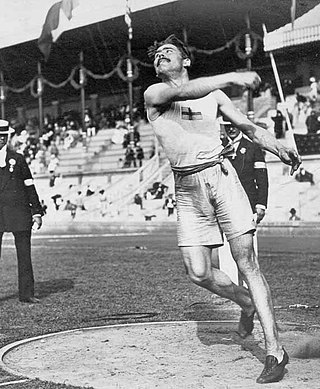
The men's two handed discus throw was a track and field athletics event held as part of the Athletics at the 1912 Summer Olympics programme. It was the only appearance of the event at the Olympics, along with the other two handed throws. The format of the event was such that each thrower threw the discus three times with his right hand and three times with his left hand. The best distance with each hand was summed to give a total. The three finalists received three more throws with each hand. The competition was held on Saturday, July 13, 1912. Twenty discus throwers from six nations competed. NOCs could enter up to 12 athletes.
The men's 400 metres event was part of the track and field athletics programme at the 1920 Summer Olympics. The competition was held on Thursday, August 19, 1920, and on Friday, August 20, 1920. 37 runners from 16 nations competed. No nation had more than 4 runners, suggesting the limit had been reduced from the 12 maximum in force in 1908 and 1912. The event was won by Bevil Rudd of South Africa, the nation's first title in the event. Nils Engdahl's bronze was Sweden's first medal in the 400 metres.

The men's pole vault event was part of the track and field athletics programme at the 1920 Summer Olympics. The competition was held on Wednesday, August 18, 1920, and on Friday, August 20, 1920. 16 pole vaulters from seven nations competed. No nation had more than 4 jumpers, suggesting the limit had been reduced from the 12 maximum in force in 1908 and 1912. The event was won by Frank Foss of the United States, the nation's sixth consecutive victory in the men's pole vault. Henry Petersen's silver was Denmark's first medal in the event and the first time a non-American had done better than bronze in the pole vault. Edwin Myers's bronze continued the American streak of winning at least two medals in each pole vault, however.

The men's long jump event was part of the track and field athletics programme at the 1920 Summer Olympics. The competition was held on Tuesday, August 17, 1920, and on Wednesday, August 18, 1920. 29 long jumpers from eleven nations competed. No nation had more than 4 runners, suggesting the limit had been reduced from the 12 maximum in force in 1908 and 1912. The event was won by William Petersson of Sweden, the first time an athlete not from the United States took gold in the long jump.

The men's triple jump event was part of the track and field athletics programme at the 1920 Summer Olympics. The competition was held from Thursday, August 19, 1920, to Saturday, August 21, 1920. Twenty-one triple jumpers from eight nations competed. No nation had more than four jumpers, suggesting the limit had been reduced from the 12 maximum in force in 1908 and 1912. The event was won by Vilho Tuulos of Finland, the nation's first medal in the triple jump. Sweden, which had swept the medals in 1912, took the next three places. Erik Almlöf became the third man to win two medals in the event, repeating his bronze performance from 1912.
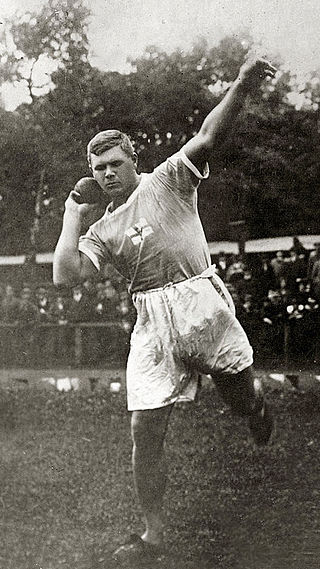
The men's shot put event was part of the track and field athletics programme at the 1920 Summer Olympics. The competition was held on Tuesday, August 17, 1920, and on Wednesday, August 18, 1920. Twenty shot putters from ten nations competed. No nation had more than 4 athletes, suggesting the limit had been reduced from the 12 maximum in force in 1908 and 1912. The event was won by Ville Pörhölä of Finland, the first time the men's shot put was won by someone not from the United States. Fellow Finn Elmer Niklander took silver. The Americans, who had won all five previous editions of the shot put, including three medal sweeps, settled for bronze by Harry B. Liversedge.
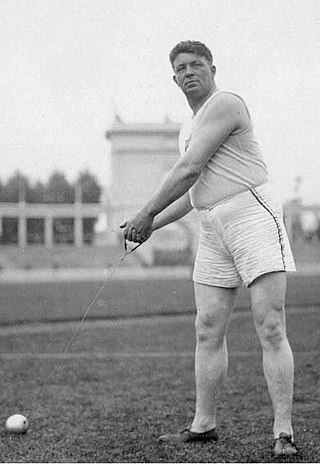
The men's hammer throw event was part of the track and field athletics programme at the 1920 Summer Olympics. The competition was held on Wednesday, August 18, 1920. 12 throwers from 5 nations competed; four from Sweden, four from the United States, two from Canada, one from Great Britain, and one from Finland. No nation had more than 4 athletes, suggesting the limit had been reduced from the 12 maximum in force in 1908 and 1912. The event was won by Patrick Ryan of the United States, the nation's fifth consecutive victory in the event. Carl Johan Lind took silver, earning Sweden's first medal in the hammer throw. Another American, Basil Bennett, earned bronze.

The men's discus throw event was part of the track and field athletics programme at the 1924 Summer Olympics. The competition was held on Sunday, July 13, 1924. 32 discus throwers from 18 nations competed. The maximum number of athletes per nation was four. The event was won by Bud Houser of the United States, the nation's fourth victory in the men's discus throw ; the Americans had medalled in each of the Olympic discus throw events to date. Houser had also won the shot put. Vilho Niittymaa took silver, keeping Finland on the podium in the event for the third straight Games. Thomas Lieb gave the United States its second discus throw medal of 1924, with his bronze.

The men's shot put event was part of the track and field athletics programme at the 1924 Summer Olympics. The competition was held on Tuesday, July 8, 1924. 28 shot putters from 15 nations competed. The maximum number of athletes per nation was 4. The event was won by Bud Houser of the United States, the nation's sixth victory in the men's shot put. Glenn Hartranft took silver and Ralph Hills took bronze to complete the Americans' fourth medal sweep in the event.
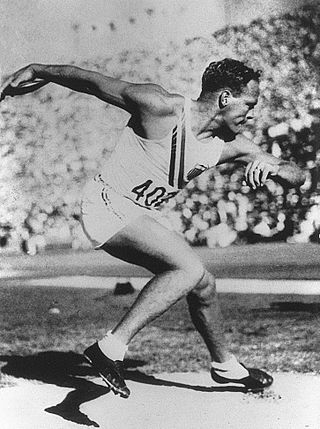
The men's discus throw event at the 1932 Olympic Games took place August 3. Eighteen athletes from 11 nations competed. The 1930 Olympic Congress in Berlin had reduced the limit from 4 athletes per NOC to 3 athletes. The event was won by John Anderson of the United States, the nation's third consecutive and sixth overall victory in the men's discus throw. Henri LaBorde took silver, marking the first time since 1908 that the same nation had the top two discus throwers. Paul Winter was the bronze medalist, earning France's first discus medal. Finland's four-Games podium streak ended, while the United States extended its streak to all nine appearances of the event.

The men's discus throw event was part of the track and field athletics programme at the 1936 Summer Olympics. The competition was held on August 5, 1936. Thirty-one athletes from 17 nations competed. The maximum number of athletes per nation had been set at 3 since the 1930 Olympic Congress. The final was won by Ken Carpenter of the United States. It was the nation's fourth consecutive, and seventh overall, victory in the men's discus throw; it was also the second consecutive Games that the Americans finished with both of the top two places, as Gordon Dunn took silver. Giorgio Oberweger earned Italy's first men's discus throw medal with his bronze.

The discus throw is one of four track and field throwing events held at the Summer Olympics. The men's discus throw has been present on the Olympic athletics programme since 1896. The women's event was first contested at the 1928 Olympics, being one of the five athletics events in the inaugural Olympic women's programme.



















